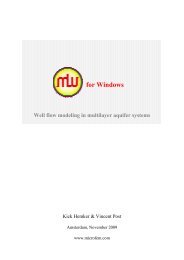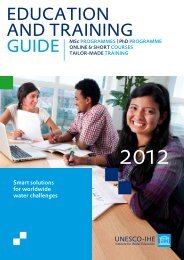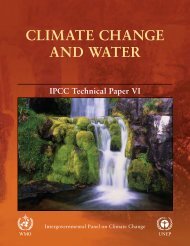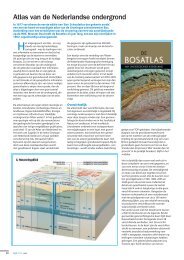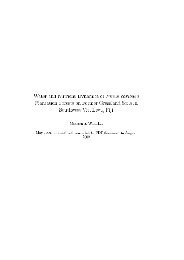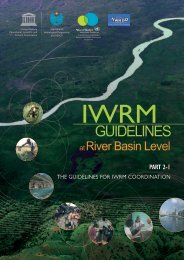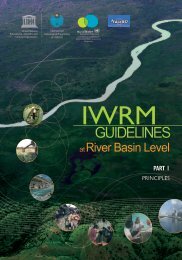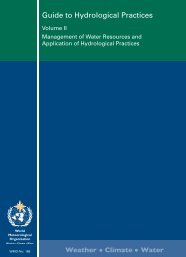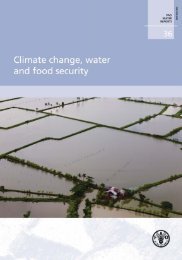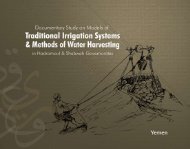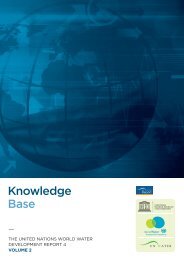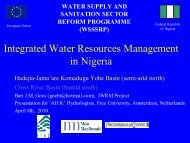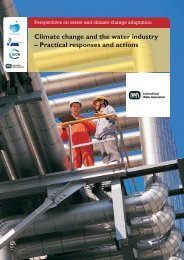Non-renewable groundwater resources: a ... - unesdoc - Unesco
Non-renewable groundwater resources: a ... - unesdoc - Unesco
Non-renewable groundwater resources: a ... - unesdoc - Unesco
- No tags were found...
Create successful ePaper yourself
Turn your PDF publications into a flip-book with our unique Google optimized e-Paper software.
NON-RENEWABLE GROUNDWATER RESOURCEScountries concerned with the future of the system need to come together and find a way tojointly manage the Saharan Basin.Authorities in these three countries, well aware of these risks, have begun joint studiesunder the supervision of Observatoire du Sahara ET du Sahel (OSS). In 1998 the OSS obtainedsupport from the Swiss Agency for Development and Cooperation, the International Fund forAgricultural Development (IFAD) and the UN Food and Agricultural Organization (FAO) for afirst three-year study that continued up until December 2002.The objectives and activities of these studies focus on improved hydrogeology, an informationsystem, a mathematical model, and a consultation mechanism. There now exists a fiftyyear(1950–2000) historic record of the piezometry, water salinity, and its exploitation.The results of this improved knowledge of the basin’s hydrogeology is a schematization ofthe aquifers needed for a mathematical model. The Saharan basin is a large multilayered, sedimentaryentity. The combined representation of the individual aquifers – permeable and semipermeable– makes it possible to account for the hydraulic and chemical connections andexchanges among all of the basin’s aquifers and thus, the performance of the system in themedium and long terms.The NWSAS database and model simulations70The implementation of a shared database permits studies to be carried out simultaneouslyat each of the project’s head offices and by each of the respective administrative authoritiesfor water within each of the three countries. Creating this database involves multiple diverseoperations at over 9,000 water points, including collecting, homogenizing the systems for classificationand identification, reviewing, detecting faulty data, correcting, and validating. Thismanagement tool contains data of high quality and is now available for use.Management with full factual knowledge of the Aquifer System is facilitated by the availabilityof a mathematical simulation model. This model provides predictions given variousmanagement scenarios. The reference period chosen for the simulations is the historical period1950–2000, assuming the initial situation as existed in 1950.Many alternative policies in each country have been simulated to predict their combinedeffects on the aquifer. A reference pattern, named scenario zero, was also defined. It consists inholding constant the withdrawals from drilled wells carried out in the year 2000, and calculatingthe system’s corresponding evolution over 50 years.Other policies included:● In Algeria, two patterns:■ A so-called strong policy representing an additional withdrawal of 101 m 3 /s, whichwould increase Algerian withdrawals from 42 to 143 m 3 /s during the first 30 years.■ A so-called weak policy assumption for an additional withdrawal of 62 m 3 /s, whichwould increase the withdrawals from 42 to 104 m 3 /s.■ In Tunisia: the contemplated policy anticipates that the savings realized from improvementin the efficiency of irrigation will compensate for the additional demand of the newirrigated areas, which corresponds to the maintenance of the present withdrawals.● In Libya: the exploratory simulations concern two programmes of the Great Man-madeRiver Project (GMRP): an additional flow of 90 km 3 /year from the pumping field ofGhadames-Derj with the collecting field of Djebel Hassaounah.



